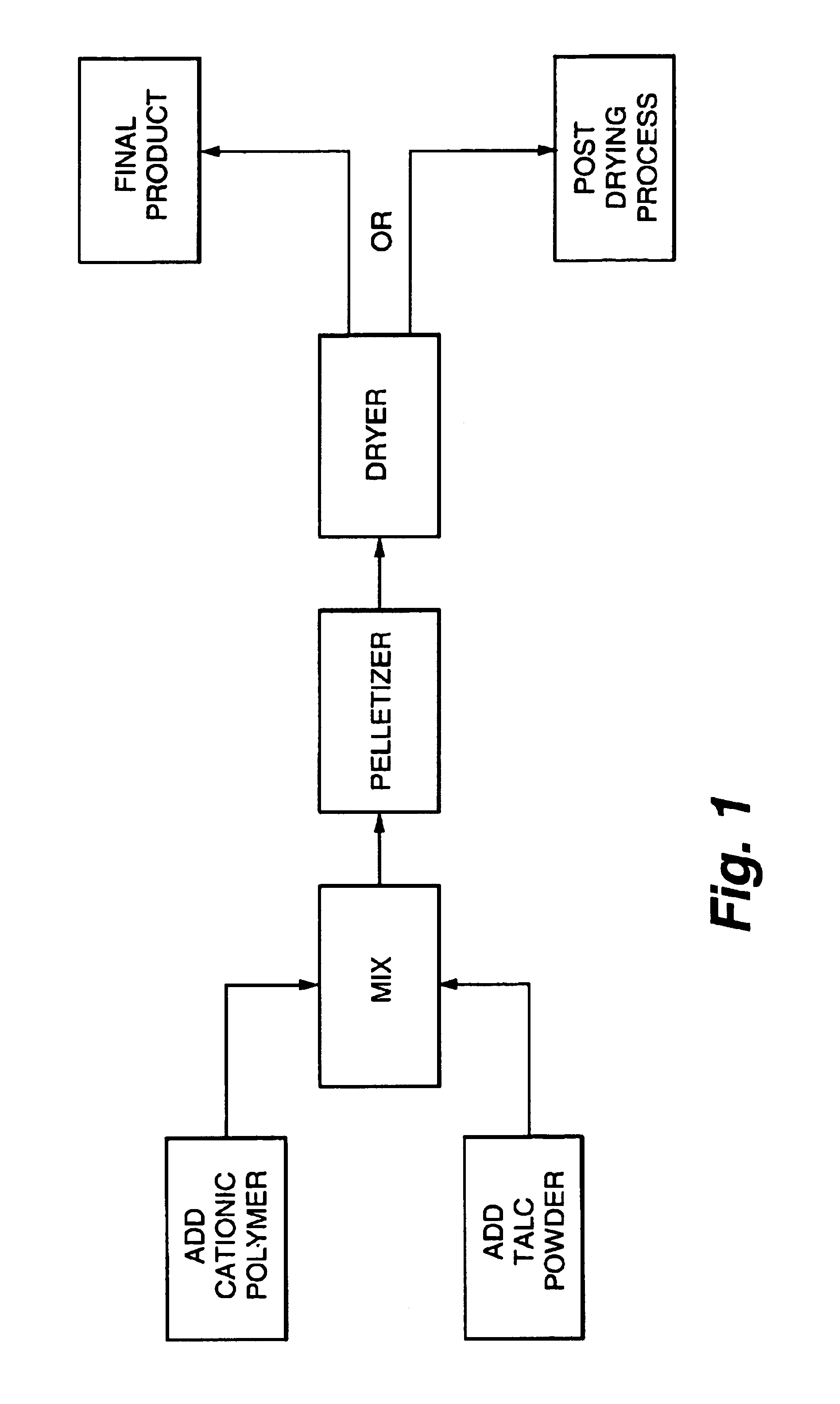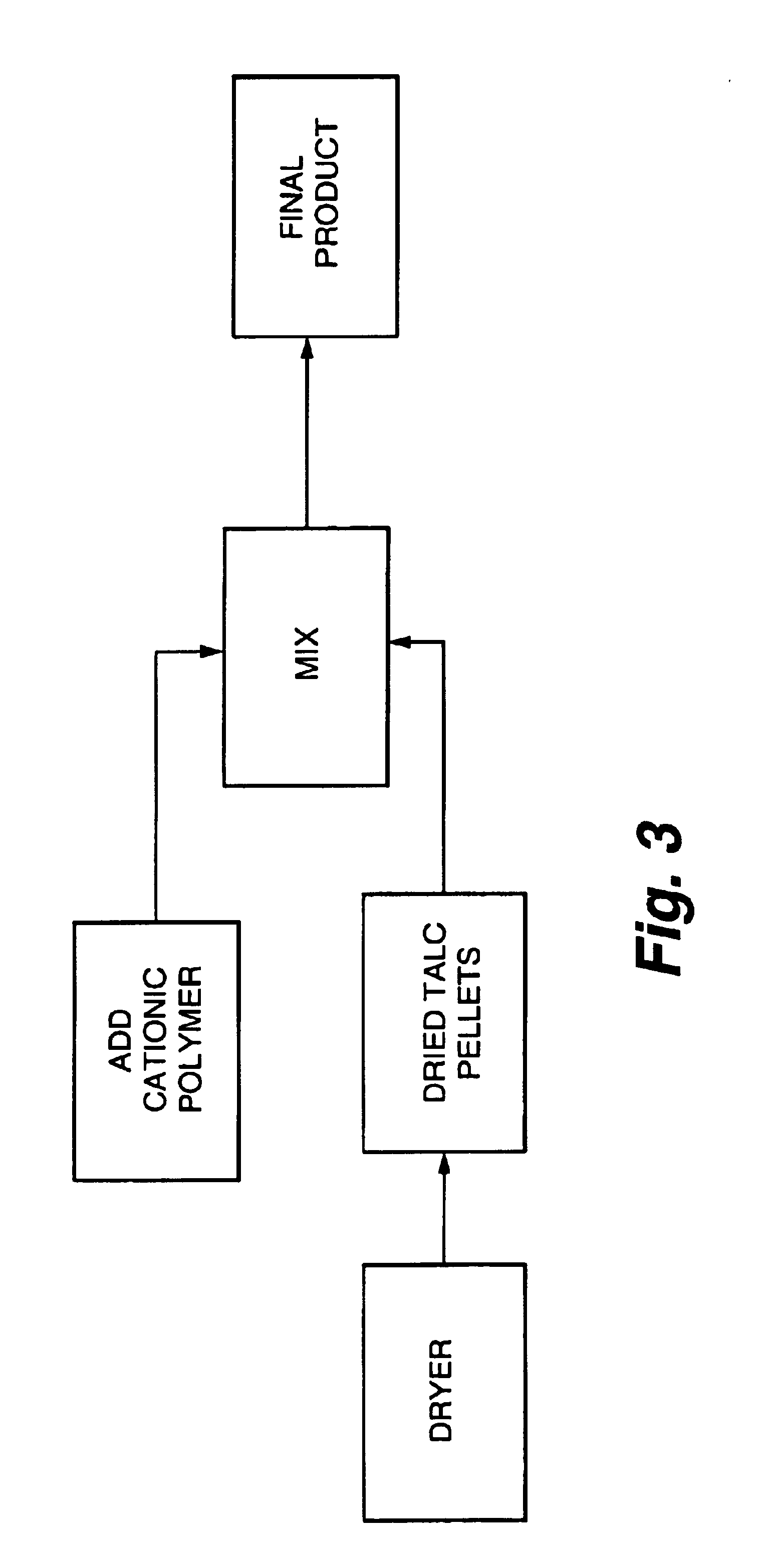Additive and process for sticky control in recycled pulps
a technology of additives and recycled pulps, applied in the field of chemical additives and a process for making additives, can solve the problems of affecting the adhesion of paper to the fiber, and affecting the quality of paper,
- Summary
- Abstract
- Description
- Claims
- Application Information
AI Technical Summary
Problems solved by technology
Method used
Image
Examples
example 1
[0032]The first experiment performed was to test a catonized talc, i.e., talc treated with only a polydadmac against a control and a conventional talc. An OCC pulp from a mill was used in this study. Four samples of pulp were prepared: one without talc (control), one with conventional talc, and two with cationized talc at different dosages. The results of the deposition testing described above are listed in Table 2.
[0033]
TABLE 2Results of Polydadmac TestingDosageDepositable MaterialTreatment(lbs of talc / ton OCC)g / ton OCC% ReductionControl 0400Conventional talc40410(no polymer)Mistron Plus203122.5Mistron Plus401367.5
[0034]The results show that the treated talc provides a reduction in stickies deposited on the stirrer. The results also show that the percent reduction increases with an increase in the amount of treated talc added to the OCC pulp. Thus, it is clear that a polydadmac treated talc will significantly reduce stickies.
[0035]While it is possible to add a polydadmac treated ta...
example 2
[0036]The polymers chosen to be evaluated in this example were polyamine (PA), polyethyleneimine (PEI), and polydadmac (PD). Since the three polymers have different molecular weights and other properties, a dosage level of each polymer that produce an identical talc particle charge of 15 μeq / g was used to treat the talc. To attain the desired particle charge, the polymers were added as follows:
[0037]
Polyamine:0.58% activePolydadmac:0.62% activePEI:0.93% active
[0038]The polymers were added to the talc substantially according to the procedure described above. In the case of the PA and PD, the talc slurry was created without pH adjustment. However, the pH of the talc slurry with PEI was adjusted to a pH of about 5 with dilute sulfuric acid. The three polymers were compared in terms of their ability to control stickies at two talc dosage levels using an OCC pulp furnish. The results are shown in Table 3.
[0039]
TABLE 3Results of Comparison of PD, PA, and PEIDosageDepositable MaterialTreat...
example 3
[0041]Since the results of Example 2 clearly show that PA and PEI treated talcs reduces stickies, the next step was to optimize the polymer treatment in order to obtain a good balance between cationicity of talc edges and hydrophobicity of the planar surface of the talc particles. As discussed above, if too much amine is added to the talc particle slurry, the amine will turn the entire surface of the talc particles from anionic to cationic. Thus, an optimum range of cationic polymer to be added to the talc particles and also the optimum treated talc dosage to the recycled fibers were determined. This optimization study was conducted using PA instead of PEI for the following reasons (1) being a quaternary amine, PA's efficiency is not affected by pulp stock pH, unlike PEI, a tertiary amine, and (2) PA costs less than PEI. Different OCC pulps of varying levels of colloidal anionic trash and chemical oxygen demand (COD) were used to cover the broad spectrum of OCC pulp quality. The res...
PUM
| Property | Measurement | Unit |
|---|---|---|
| pH | aaaaa | aaaaa |
| total weight | aaaaa | aaaaa |
| total weight | aaaaa | aaaaa |
Abstract
Description
Claims
Application Information
 Login to View More
Login to View More - R&D
- Intellectual Property
- Life Sciences
- Materials
- Tech Scout
- Unparalleled Data Quality
- Higher Quality Content
- 60% Fewer Hallucinations
Browse by: Latest US Patents, China's latest patents, Technical Efficacy Thesaurus, Application Domain, Technology Topic, Popular Technical Reports.
© 2025 PatSnap. All rights reserved.Legal|Privacy policy|Modern Slavery Act Transparency Statement|Sitemap|About US| Contact US: help@patsnap.com



